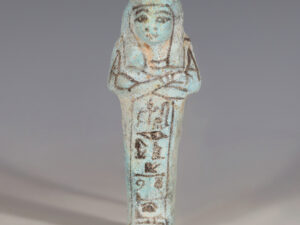Shabtis or ushabtis are among the most numerous of all Egyptian antiquities, as they played a major role in funeral rites. Indeed, they were intended to act as servants for the deceased and to perform any manual labour for their master in the afterlife. For this to be possible, it was necessary that each shabti present in the grave had the name of their master inscribed on it and also a summoning spell to which they replied. In fact, shabti – or ushabti – translates as “the answerer”. Such figurines could also be inscribed with passages from the Book of the Dead, the intention of which was to secure safety for the deceased in the afterlife. The name Padiwsr features on a number of shabtis from the Late period, suggesting it was a recognised name. The name Padiwsr/Padiusir was Hellenised as Petosiris. This particular figure was a priest of the goddess Smentet, a lesser known goddess associated with Isis and Osiris, and a priest of the temple of Ptah-un, the patron god of Memphis.
Ancient Egyptian Faience Ushabti for Padi-Usir
$2,647.48
A very finely modelled Ancient Egyptian turquoise glazed faience shabti, featuring a dorsal pillar to the reverse and a rectangular base. The shabti is shown wearing a tripartite wig and a plaited false beard and holding a pick and a hoe in his crossed arms, with a basket hanging over his left shoulder. The body has been inscribed with hieroglyphs in a T-shaped bar formation. The moulded details remain very well preserved, with very clear facial features and hieroglyphs.
The horizontal bar transliterates as:
Sḥḏ Wsir smntt ḥm-nṭr p-di-Wsir
The vertical bar transliterates as:
Ms n ir-b-n-t [mwt], m3’-ḫrw
This translates as:
The Illuminated, the Osiris, priest of [the goddess (implied)] Semenet, Padiusir,
Born of Irbinat, [mother (implied)], the justified.
Out of stock
Additional information
| Weight | 74.6 g |
|---|---|
| Dimensions | 12.8 × 3.6 cm |
| Culture | Ancient Egyptian |
| Faience | Turquoise Faience |
| Region | North Africa |

















